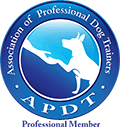Archive OLDT :: From Dolphins to Dogs -- To Click or Not To Click
Our history with dogs is paved with many years of striving for obedience through the employment of correction and punishment. It's thanks to the work that marine animal trainers were doing with dolphins and other marine animals that we learned a different approach.
With dolphins, it's difficult to compel them to do anything -- they will simply swim away if they don't want to comply. So instead marine trainers would use a whistle, which could be heard under water and at a distance, to mark the moments when the animal performed a desired behavior. The sound of the whistle would indicate to the dolphin that reward had been earned.
Though it's painfully easy to compel dogs to bend to our will, through leash jerks and jolts of shock, training needn't be like this. Like any organism learning new behaviors, a dog who is reinforced for performing the desired behavior is encouraged to learn, experiment, and offer new behaviors. Clicker training, like whistle training with dolphins, is a very effective application of this.
Using a Clicker
Using a clicker to train is much like using a happy "yes!" to mark the behavior you're trying to train, or to take a picture of the desired behavior. The secret to training is timing, and placement of the "yes!" or the click must be accurate in order for your dog to learn a behavior quickly. To use the clicker, first you must "charge it up", which means that you need to establish with your dog that the sound of a click is reinforcing or rewarding. To do this, randomly click and then produce a treat. Do this over and over again until, when he hears the click, your pup turns his head in happy anticipation. Then you know an association has been established. Now, just as you've trained any other behavior, placing the "yes!" at the exact moment when the behavior happens (like a "sit" being when his/her butt touches the ground), click him for a successful performance of the behavior and give him a treat. Remember: the timing of the success marker is the important thing here, not the delivery of the treat! The clicker can be particularly helpful when training a behavior by luring it, capturing it or shaping it.
Training by Luring
For simple behaviors such as "sit" or "down", lure-based training is usually the most straightforward approach. In this kind of training, a treat is used to lure the dog into the desired position. With repetition, he learns to perform the behavior simply upon seeing the hand signal. Then a verbal cue can be attached to the hand signal.
Training by Capturing
Training by capturing means that, rather than manipulating your dog in some way to perform the behavior (like luring him to sit), you wait for him to voluntarily perform the behavior and then mark it (either with a "yes!" or a click). An example of a behavior that might be difficult to train in a way other than capturing is sneezing, which is usually a voluntary behavior. To capture it would be to click whenever your pup happens to sneeze and then give him a treat.
As always, behaviors that are reinforced (rewarded) are more likely to be repeated, so over time your dog is more likely to sneeze because he's been reinforced for it in the past. Then you can attach a verbal cue to it.
Training through Shaping
Shaping is a training technique in which successive approximations of a (usually complex) behavior are reinforced until the goal behavior is accomplished. A simple example could be the "are you shy?" behavior. The complete behavior would be for your dog to put his head on the floor between his paws. Start with your dog in a down. Click him for a slight head duck, the head bobbing down just a bit from level. As always, behaviors that are reinforced (rewarded) are more likely to be repeated, so your pup will start to duck his head more often, but in some of the repetitions he'll duck a bit lower than others. Once it's become a consistent behavior to duck, start clicking only for those lower head bobs. You'll notice that your dog will start to bob his head lower and lower. At some point, click only for those bobs where his jaw actually touches the floor, even if just for a moment. Do you see how we've shaped this behavior just by selecting for successive approximations? The key, though, is not to jump to the next level of performance until your dog is consistently offering the current level, or you will get a weak behavior that is easily lost.




